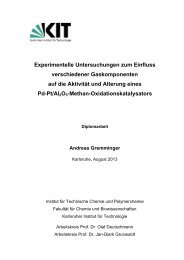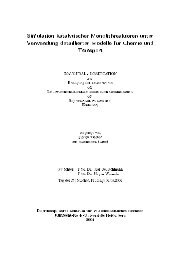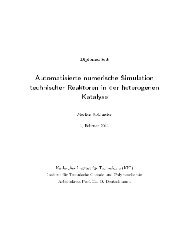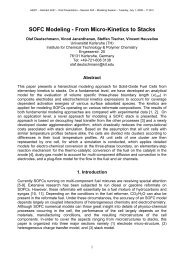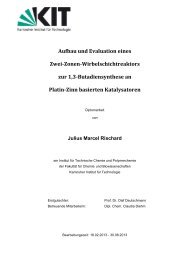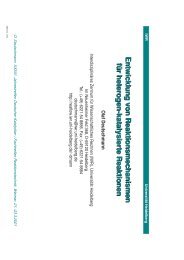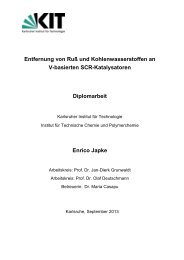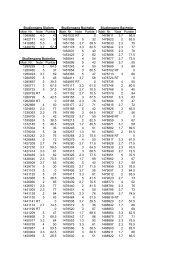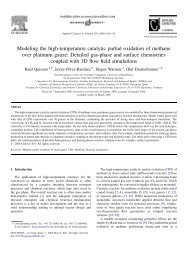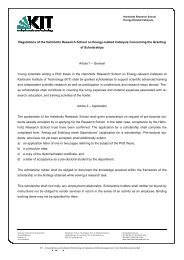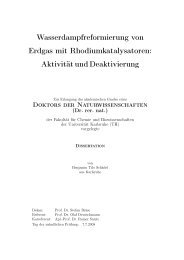Fuel Processing for Fuel Cells - Institut für Technische Chemie und ...
Fuel Processing for Fuel Cells - Institut für Technische Chemie und ...
Fuel Processing for Fuel Cells - Institut für Technische Chemie und ...
Create successful ePaper yourself
Turn your PDF publications into a flip-book with our unique Google optimized e-Paper software.
Author's personal copy<br />
46 Torsten Kaltschmitt and Olaf Deutschmann<br />
reaction scheme, such as the one given in Section 4.2, little insight can be<br />
gained from such a lumped mechanism. There<strong>for</strong>e, it is recommended to<br />
apply chemical models based on elementary-step reaction mechanisms<br />
<strong>for</strong> <strong>und</strong>erstanding the reaction routes.<br />
7.1.1 Reaction networks in the re<strong>for</strong>ming of methane<br />
For reaching a profo<strong>und</strong> <strong>und</strong>erstanding of the reaction mechanism of<br />
synthesis gas <strong>for</strong>mation from methane by SR, POX, ATR, and DR, the<br />
sequence and interaction of the reaction routes have to be analyzed <strong>for</strong><br />
the combined POX-SR-DR systems, because the conditions in any flow<br />
reactor vary along the flow directions, covering a wide range of mixture<br />
compositions and leading to quite diverse local reaction rates. There has<br />
been a long discussion in literature on the reaction routes in CPOX of<br />
methane over Rh and Pt catalysts at short contact times (Deutschmann<br />
et al., 2001; Hickman and Schmidt, 1993a,b; Horn et al., 2007, 2006;<br />
Schwiedernoch et al., 2003). The crucial point of this discussion was on<br />
the <strong>for</strong>mation route of hydrogen. One possible route is direct POX. The<br />
other one is an indirect route, in which, at first, total oxidation occurs and<br />
subsequently hydrogen is <strong>for</strong>med by SR of the remaining fuel. Detailed<br />
reaction schemes <strong>for</strong> the CPOX of methane over platinum and rhodium,<br />
which also include steps <strong>for</strong> SR, were published by Schmidt et al.(Hickman<br />
and Schmidt, 1993b), Vlachos et al. (Maestri et al., 2008; Mhadeshwar and<br />
Vlachos, 2005, 2007; Mhadeshwar et al., 2003), and Deutschmann et al.<br />
(Deutschmann et al., 1994, 1996; Quiceno et al., 2006; Schwiedernoch et al.,<br />
2003). A unified mechanism covering all aspects of SR and DR, POX and<br />
total oxidation, carbon <strong>for</strong>mation, and catalyst oxidation is still <strong>und</strong>er<br />
construction. Recently obtained new experimental data <strong>for</strong> DR (McGuire<br />
et al., 2011) call <strong>for</strong> further adaption of the kinetic schemes available.<br />
Based on a variety of experimental and modeling techniques, a general<br />
consensus is now achieved on the reaction routes in CPOX over Rh catalysts:<br />
In a quasi two-step process (indirect route), first CH 4 is completely<br />
oxidized to CO 2 and steam, as long as oxygen is present close to the catalyst<br />
surface, and then the remaining CH 4 is re<strong>for</strong>med with the steam to synthesis<br />
gas (Hannemann et al., 2007; Horn et al., 2010; Schwiedernoch et al.,<br />
2003). DR does not play any significant role and the surface acts as a sink <strong>for</strong><br />
radicals, inhibiting significant gas-phase reactions at pressures below 10<br />
bars (Quiceno et al., 2006). The reaction is mass transport limited, in particular<br />
in the total oxidation zone of the reactor, in which the surface reaction<br />
rate is very fast in comparison to diffusion of oxygen to the channel wall,<br />
which leads to almost zero oxygen concentrations at the gas–catalyst interphase.<br />
The decisive proof <strong>for</strong> this reaction route came from the application<br />
of in situ techniques to determine spatially resolved species and temperature<br />
profiles inside the reactor. The optically accessible catalytic channel



